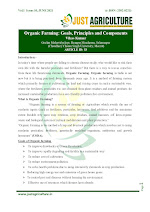Plant Growth Regulators (PGRs) or phytohormones. These are organic compounds produced in trace amounts that orchestrate the entire lifecycle of plants—from seed germination to flowering and fruiting.
What Are Plant Growth Regulators?
Plant Growth Regulators are organic substances, naturally produced in plants, that influence physiological processes such as growth, development, dormancy, and senescence—even when transported to a site far from where they were synthesized. They're effective in minute quantities, making them incredibly potent messengers in plant metabolism.
Note: The term phytohormone was first used by Thimann (1948), and auxin—the first discovered hormone—was isolated by Went (1928) using the Avena curvature test.
Hormones vs. Plant Growth Regulators
| Criteria | Plant Hormones | Plant Growth Regulators |
|---|---|---|
| Nature | Endogenous (naturally occurring) | Can be natural or synthetic |
| Examples | Auxin, Gibberellin, Cytokinin, ABA, Ethylene | Includes 2,4-D, NAA, CCC, TIBA, etc. |
| Action | Regulate physiological processes | Modify growth or development |
Exception: Ethylene, being a gas, acts near its production site and doesn’t fit the classical hormone definition.
The Five Major Groups of Plant Hormones
1. Auxins
- Discovered by: Went (1928), Kogl & Haagen-Smit (1931)
- Natural Auxin: Indole-3-acetic acid (IAA)
- Synthetic Auxins: IBA, NAA, 2,4-D, MCPA, TIBA
Key Functions:
- Promotes cell elongation, apical dominance, and root initiation
- Prevents abscission of leaves and fruits
- Induces parthenocarpy (fruit without fertilization)
- Enhances callus formation and respiration
- Used in weed control and promoting flowering
Biosynthesis: Derived from tryptophan via indole-3-pyruvic acid or tryptamine pathways.
Transport: Polar (basipetal in shoots), inhibited by TIBA and NPA (antiauxins).
Destruction: By IAA oxidase, UV light, X-rays.
2. Gibberellins (GA)
- Discovered from: Gibberella fujikuroi-infected rice by Kurosawa
- Main Precursor: Acetate → Mevalonic acid → Gibberellins
Key Functions:
- Seed germination in dark (replaces light requirement)
- Breaks dormancy in buds and tubers
- Stimulates stem elongation and bolting
- Promotes parthenocarpic fruit development
- Stimulates α-amylase synthesis in cereal grains
- Used to grow seedless grapes, bigger fruits, and enhance flowering in long-day plants.
3. Cytokinins (Kinetin)
- Discovered by: Skoog and Miller (1950)
- Common Cytokinin: Zeatin (from maize), Coconut milk factor
Key Functions:
- Induce cell division and enlargement
- Counteract apical dominance
- Delay leaf senescence (Richmond-Lang Effect)
- Promote flowering and morphogenesis
- Aid in solute translocation and protein synthesis
Biosynthesis: Synthesized in root tips, transported via xylem.
Commercial Use: Prolong shelf life of vegetables/fruits, improve oilseed yield, enhance tissue culture regeneration.
4. Ethylene
- Nature: Only gaseous plant hormone
Key Functions:
- Speeds up fruit ripening (banana, apple, tomato)
- Causes leaf abscission, flower fading, and epinasty
- Induces flowering in pineapple
- Inhibits root elongation but promotes adventitious roots
- Ethylene is often used in agriculture for synchronized ripening and flower induction.
5. Abscisic Acid (ABA)
- Discovered by: Addicott (1963); originally called Abscissin II
Key Functions:
- Induces dormancy in seeds and buds
- Causes stomatal closure during water stress
- Promotes leaf senescence, abscission, and tuberisation
- Enhances frost resistance in temperate plants
- ABA is synthesized in chloroplasts, especially during drought, and moves into guard cells to reduce transpiration.
Growth Retardants: The Anti-Hormones
These synthetic compounds suppress gibberellin activity, limiting excessive growth, especially useful in horticulture and floriculture.
Examples:
- CCC (Cycocel) – Reduces internode length
- Phosphon D
- AMO-1618
- Morphactins
- Maleic Hydrazide
They are used to control plant height, induce early flowering, and enhance stress resistance.
| Plant Hormone | Key Functions | Examples |
|---|---|---|
| Auxins | • Promote cell elongation • Maintain apical dominance • Root initiation in cuttings • Prevent premature fruit fall | IAA, IBA, NAA |
| Gibberellins (GAs) | • Promote stem elongation • Break seed dormancy • Induce flowering in long-day plants • Used in dwarf breeding | GA₃, GA₁ |
| Cytokinins | • Promote cell division • Delay senescence (anti-aging) • Promote shoot growth • Used in tissue culture | Kinetin, Zeatin, BAP |
| Ethylene | • Ripens climacteric fruits • Promotes leaf & fruit abscission • Stimulates flowering in pineapple • Breaks dormancy | Ethylene gas, Ethrel (Ethephon) |
| Abscisic Acid (ABA) | • Inhibits growth • Induces dormancy • Promotes stomatal closure during drought • Enhances stress tolerance | ABA (natural) |
| Growth Retardants | • Reduce internodal growth • Maintain compact plants • Control excessive vegetative growth | CCC, MH, SADH, TIBA |










0 Comments